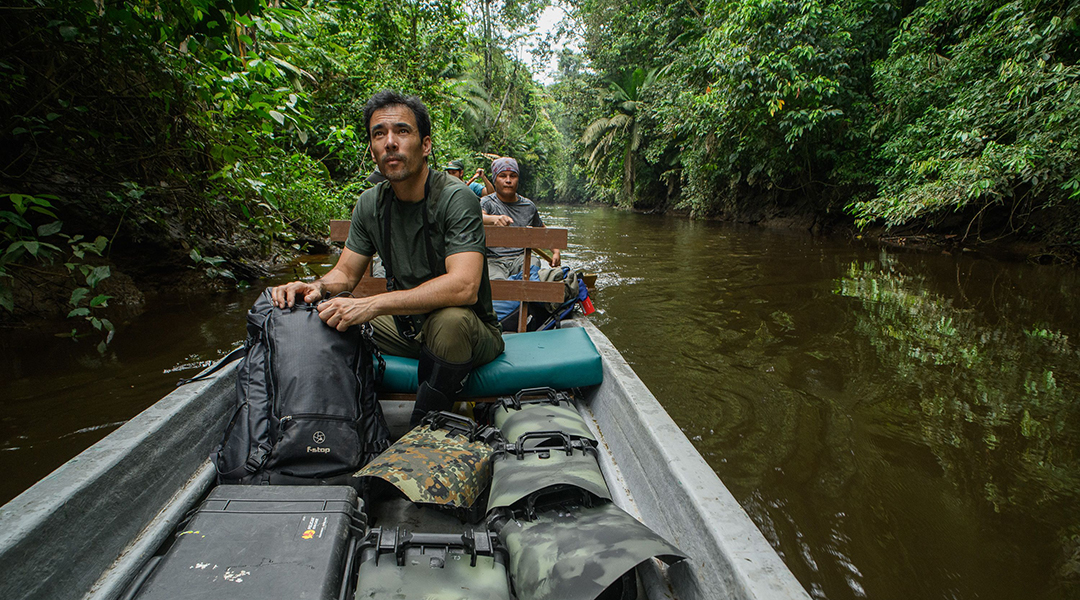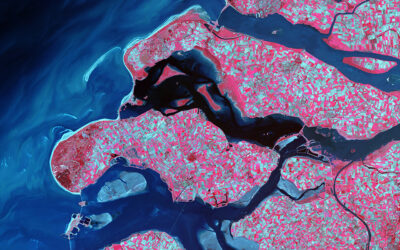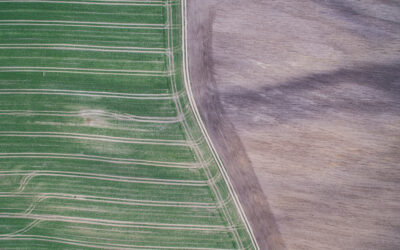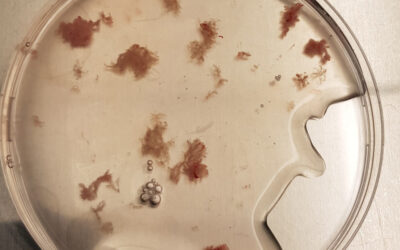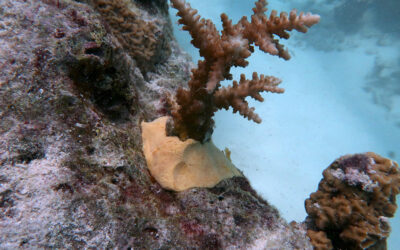Scrolling through the vivid mosaic of photographs taken by wildlife photographer, ecotourism guide, conservationist, and ecologist Chien Lee, awe is the first emotion that arises. These mesmerizing images intimately capture the weird and wonderful plants and animals that inhabit the world’s rainforests, with a focus on Borneo, the world’s third-largest island and Lee’s home for the past 27 years.
A California native, Lee first came to Kuching, the capital of Sarawak, a state on the Malaysian side of the island, to set up a facility for the propagation of carnivorous pitcher plants. Here, Lee cultivated his love of the rainforest, documenting his expeditions deep into the jungles of Borneo through his camera lens.
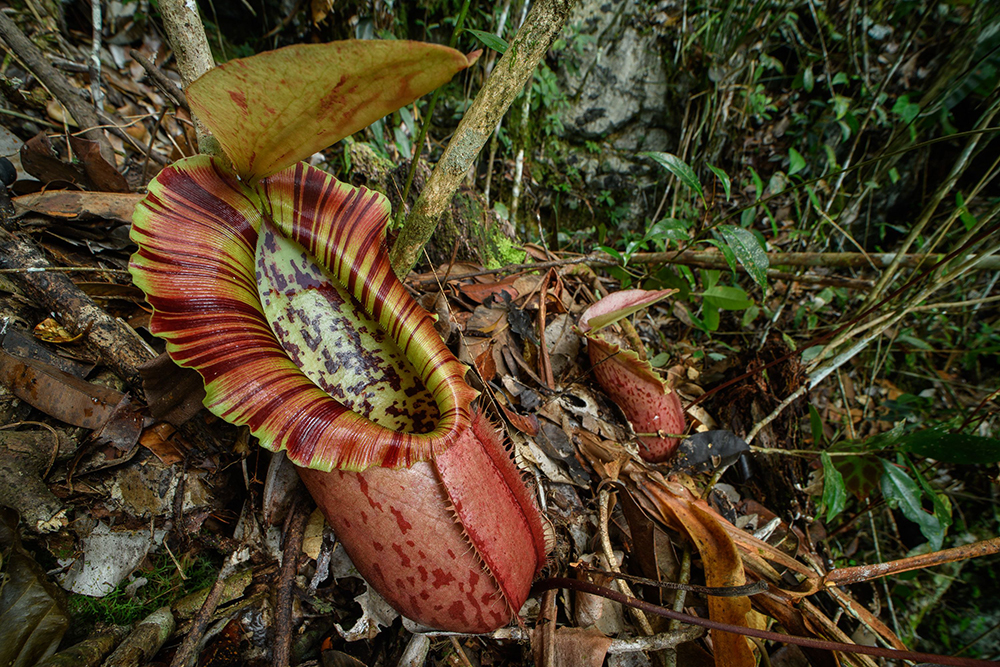
Through his photos, which have been featured in various exhibitions, and his talks/workshops, Lee not only aims to educate the public about the diverse species that inhabit these rainforests — some of them unnamed or endangered — but to ease people’s fears and inspire compassion for the natural world. By raising awareness of the issues faced by the rainforest and its vulnerable wildlife, he’s an integral part of the effort to protect them from disappearing.
Like other rainforests of the world, those of Borneo, which is partially Malaysian, partially Indonesian, and hosts the tiny country of Brunei, have been gradually diminishing. Logging/deforestation, mining, monoculture plantations, and hydroelectric mega-dams are among the major threats posed by humans. In addition, the World Wildlife Fund predicts that climate change will drastically increase the risk of natural disasters such as flooding and wildfires, reducing Borneo’s agricultural yields and biodiversity and degrading infrastructure.
Lee talked to us about some of these threats, what makes the Borneo rainforest unique, and how he became a wildlife photographer.
You grew up in California and majored in ecology. Afterwards, you worked as an environmental educator. What exactly did that role involve?
Actually, it wasn’t after I got my degree, but during my degree, I had a position working in one of the parks in California as a student aide and then as a naturalist, where our role was basically to act as interpreters. And by interpreters, I don’t mean interpreting a language — you are an interpreter of the natural world to the general public. This involved taking schoolchildren on hikes and conducting interpretive programs about snakes or edible plants — whatever piqued our interest.
It was a great experience for me. Prior to that, I had been consumed by an interest in nature already. But growing up as a kid, my focus was always insects. I was the “bug kid,” you know. Everywhere we went on a family holiday, I’d bring my butterfly net, and by maybe only 10 years old — maybe somewhere between 10 and 12 years old — I had already started what we called the “Bug Club” in my neighborhood. All the kids would come to my house on Sunday mornings, and these were kids younger than me, anywhere between 6 to 10 years old. They paid their 25 cents dues, and then we went around the neighborhood catching and drawing pictures of bugs. We didn’t do photography back then. We were just kids.
When I graduated from high school, our neighbor, who was actually a ranger in the park said, “You would be perfect to work in our park,” and I applied and got the job. So I basically worked at the park while I was getting my degree. But as I was there, I realized by working with these other professional naturalists that, although insects were my first passion, there were also birds and plants and mushrooms and mammals, and it really opened up a lot of other interests for me. So when I first started my degree, I enrolled in entomology — the study of insects — but I quickly changed it to ecology and evolution.
That job influenced my entire direction in life. Working under these naturalists, I got to see that there’s a huge amount of skill involved in being able to speak for the voiceless. You’re responsible for conveying the truth and in piquing people’s interests about the natural world because, without an interpreter, you’re responsible for making the connection. Some of the most rewarding experiences came from inviting school groups from the inner city. This was the San Francisco Bay area, and some of these kids had never seen a live snake before, had never been for a walk in the park. So seeing their eyes open, like, pop out of their head when they touched a snake for the first time, was really an amazing experience.
When did you begin your career as a photographer? Did it just evolve naturally?
In California, it was no more than a hobby. It wasn’t until I moved to Borneo that I sort of embraced photography as a means to share all the incredible things I was finding. When I came out here, I didn’t know a single person. So, I started taking photos of everything, and it was film, but I could get them scanned. I could send people shots of what I was encountering.
What in particular fascinates you about the Borneo rainforest? What makes it unique, and how does it differ from rainforests like the Congo Basin in Africa and the Amazon in South America?
There’s so many factors involved, but Borneo is particularly characterized by some very distinctive rainforests. For one, the trees. The tallest rainforest trees on the planet are here. We have rainforests that often have canopies of over 60 to 80 meters, and we even have a 100-meter tree that was measured by somebody who actually climbed it just a few years ago. For tropical rainforests, this is exceptionally tall. These giant trees come with different trickle-down effects on all the other things in the rainforest. For example, the most dominant tree family in Borneo, the family this 100-meter tree belongs to, is called Dipterocarpaceae. When they mature, they have very few lower branches. So when you’re walking through the Borneo primary rainforest, it has a very different feel than walking through a thick jungle in Central America or Madagascar — Madagascar rainforests are very short by comparison.
This affects a lot of things. For example, Borneo is famous for having more creatures that can glide than anywhere else in the world. Everybody’s familiar with flying squirrels, of course. Well, there are a couple in North America, a couple scattered around here and there, but Borneo has 14 species of flying squirrels — and that’s just one example. We also have another mammal that can glide called the Sunda colugo. It’s this very bizarre-looking creature. It’s in its own order, actually, and glides between trees. We have, of course, gliding lizards that are very famous. These “dragons” open up their rib cage and fly like frisbees. And we have gliding frogs that have huge expanded feet and gliding geckos. There’s even a gliding snake that flattens its body and sort of swims through the air. Just incredible adaptations.
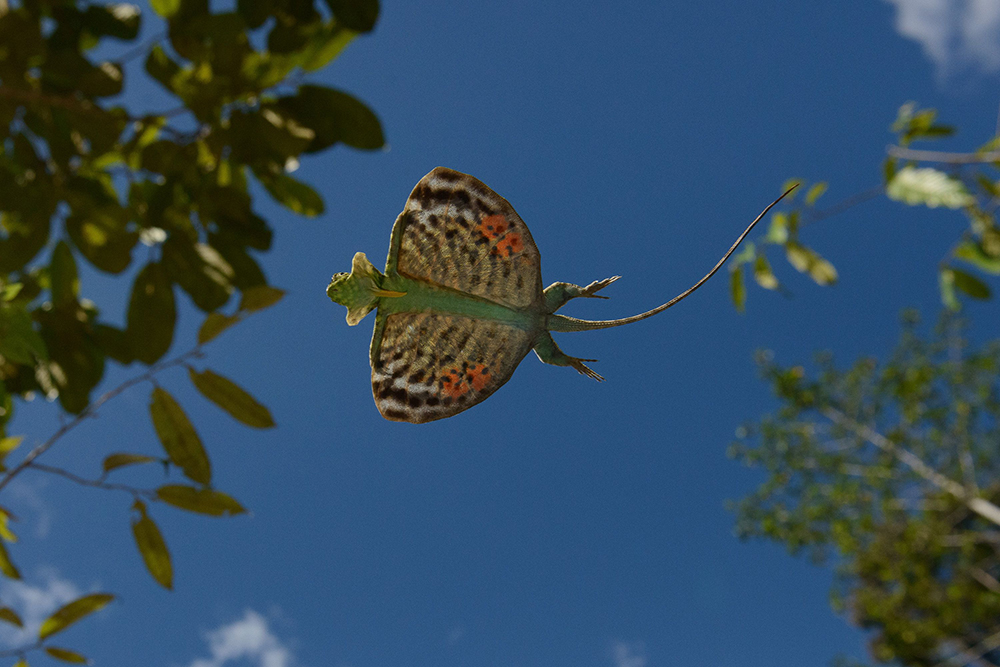
A really interesting paper looked at the fossil evidence of pollen in Borneo and elsewhere in Southeast Asia. It found that these particular giant trees became dominant sometime around 50 million years ago. And when you look at all these gliding creatures, they seem to have diverged from their non-gliding relatives around the same time, 40 to 60 million years ago or something like that.
This seems to indicate that these huge trees with few branches provided a big incentive for the evolution of gliding. So, when you look at one aspect of the rainforest and how it affects the evolution and adaptation of everything else around it, and how those will affect something else, this is the really interesting part of rainforest ecology and biogeography.
What are some of the threats that Borneo’s rainforests are facing? What efforts are being made to mitigate or prevent them?
Borneo has been suffering a lot from forest loss caused by humans. Their initial big threat was logging back in the 20th century, but when we look at logging now, compared with some of the other threats the rainforest is facing, such as monoculture plantations, burning, and huge damming of rivers, it’s much less devastating. When a forest is logged –– of course, we’re not talking about clear cutting, but selective logging––there’s still a lot of biodiversity that can maintain itself, and particularly if it’s given a chance to recover before it’s logged again. Once a forest is burned to the ground and planted with a monoculture, it can pretty much never recover naturally –– maybe in thousands or tens of thousands of years, but we don’t know. But the biodiversity, of course, is just a tiny fraction of what it was before.
There’s a great place to study in eastern Sabah, Danum Valley, which has a lot of plots, across gradients from mature rainforest to disturbed rainforest to oil palm. You can look at the species diversity here –– which animals cross that barrier, which animals can thrive on both sides, and which animals need the primary rainforest, like a stone wall they just cannot cross. F
or most rainforest organisms, it’s a very dramatic drop-off. But, of course, more work needs to be done to find out, and especially to find out how agriculture can coexist with maximized biodiversity. There are ways to do large-scale agriculture and minimize biodiversity loss. There are a lot of people who can answer this question better than I can, but, for example, proper corridors and buffer zones –– a lot of things can be done to mitigate this.
You’re working with indigenous communities in the northern interior to retain their traditional land rights. Can you tell me a bit about this project?
That’s Baram Peace Park. It’s a beautiful location in the far interior of northern Sarawak. I’ve actually only come onto this project to help with the photography and some of the wildlife flora and fauna surveying. But three NGOs that have been working with the communities there for quite a long time. So, they’re the ones who are doing all this work in helping to enable the communities to retain their land rights, even pursuing court cases. They’re doing everything there. I’m just a kind of a bystander who’s helping to showcase what’s happening with photography.
The opportunity to visit this area came about around a year and a half ago when one of my nature-tour clients approached me and said that he had some funding that he would like to donate to a photography project of mine because he likes my work, but it had to be aimed at conservation. And quite coincidentally, I knew the NGOs working in this area, so I drafted up this idea that we could produce a publication about this project, and everything seemed to work together.
So, that’s what we’ve been working on. I think we’re going to take about one more year to produce a showcase coffee-table book with images that highlight the natural beauty of this area as well as the people living there and that discusses some of the issues. But it’s mostly a celebration of why this area is so special and why it needs to be protected.
Your jungle expeditions have lasted up to two months. How do you prepare for such a long trip in the jungle? And what are the essentials you bring aside from your camera equipment?
I’ve done so many expeditions that I have a long packing list. And every time I think of something I could need in the middle of the forest, I’ll write it down on my list, and next time I will bring it up. So my list is a mile long. Things like a little folding stool, a comfortable hammock — these go a long way. But there are a lot of other little things that we’ve picked up over the years. I bring some things that people might find surprising.
I bring a super lightweight solar oven, not actually to cook, but to dehydrate silica gel to keep my camera gear dry. We have all kinds of little gizmos. The latest little gizmo I got, which I thought was really cool, is a heat pen. You put a couple of batteries in it and you press the button, and it has this little ceramic plate that heats up, almost hot enough to burn you but not quite — it’s enough to denature the proteins of an insect bite.
What is the message you want to convey (and feelings/actions you hope to evoke) through your images?
Sometimes, you know, I love just looking at beautiful images. Sometimes you don’t need any text at all and you can almost make up your own story looking at an image. I think some images can be so provocative that they really make you think, even if you don’t know the background behind it. However, I think a lot of my photography is very literal in the sense that I’m trying to convey some truth about what is happening, some unusual behavior or adaptation or something that makes this species or place significant. And what lesson can we learn about that?
Sometimes it’s just “did you realize that this does this”, and sometimes it’s conservation oriented. It can be various things. But I think it’s important that we’re trying to help as photographers. Again, we’re interpreters, basically. We’re trying to deepen understanding because that’s what paves the way for caring about nature. And that’s how things will be changed eventually.
You use camera traps and hides to photograph animals because many of them are elusive and shy. How do you pick a location for a camera trap? What’s the setup?
Depending on which part of the world you’re in, animals have a lot of different behaviors and especially habituation and fear of humans in some places. I do a lot of work in Madagascar, where the lemurs, or all the animals there, basically evolved without humans. And so there’s not a natural, innate fear of people. This is combined with the fact that a lot of the national parks are heavily visited with people, and there’s not much hunting in those areas. You can walk up to these animals, and they don’t even notice you, they don’t care. You don’t need these giant, long telephoto lenses. That’s very different from your approach in a place like Sarawak. Unfortunately, one of the things we have to deal with is a lot of bush meat hunting. In fact, there are few places I have been in the world that have as much bush meat hunting as Sarawak.
I’ve been with people slingshot tiny birds out of trees and kill snakes to eat them. I’ve seen people swerve out of their way on roads to try and run over animals because they might get a little meat out of it. It’s unfortunate. And the most unfortunate part about that is that it’s not just the people that need meat to survive –– of course, if it’s a remote community and this is their sustenance, that’s totally understandable.
But a lot of times it’s people doing it for hobby, and even worse, people doing it because they don’t even need to eat it. They just do it for fun. I’ve seen people shoot animals and then laugh about it and throw it away, and it just breaks your heart. I mean, to see a clouded leopard chopped up in a marketplace, especially if you spent years and years just trying to set eyes on one. So, hunting is a big issue here, and because of that, in a lot of the forests of Sarawak, while they still have wildlife, the animals can be extremely shy. I mean, the first sign of a human and they’re out of there. That’s why camera traps are very useful tools.
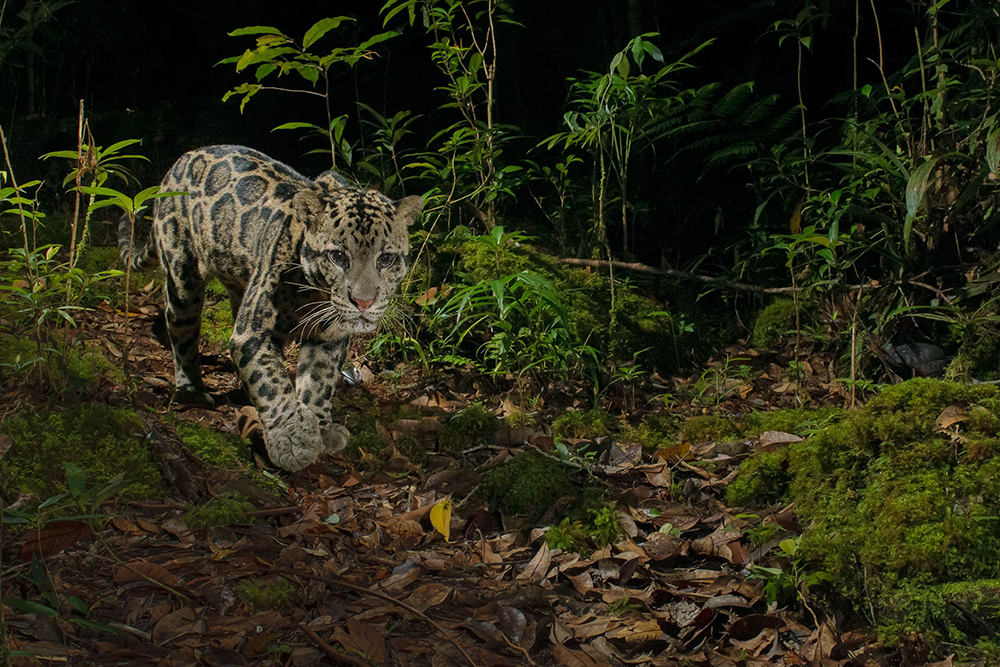
Camera trapping has actually been done for quite a while. There were camera traps even the days of film cameras. But since digital (photography), camera traps have really exploded and taken off. Of course, everybody’s familiar with the little single-unit trail cams. You can buy these at hardware stores. A lot of researchers use these. You just put batteries in, strap it to a tree, turn it on, and walk away, and it will record all the animals coming around to the front of the camera. Great for studying wildlife. However, those units –– we all call them trail channels –– usually have a limited resolution. It’s kind of a flat image. It’s basically just sufficient quality to identify what you’re looking at. So it’s for surveying.
If you want a higher-quality image, you have to do something quite different. You have to use a proper digital camera like a DSLR and hook up all the peripheries to make it function as a camera trap, and that involves having some kind of sensor apparatus. It’s usually an infrared beam or passive infrared device that detects movement, or the beam is broken, and that sends a signal to the camera. And because a lot of animals are nocturnal as well, you have to have lighting that is set up in a way that illuminates the animal nicely, and not just some blinding flash from the front or whatever.
So, you’re trying to be creative with the lighting as well. Often what people do –– and what I do –– is set up multiple flashes, like tie them to trees, at different angles that I can anticipate: if the animal is going to be here, it’ll be illuminated this way. And then, of course, all these pieces have to be completely rainproof. They have to be in hard enclosures. You can spend thousands and thousands and thousands of dollars to get expensive kits, which actually weren’t available when I started, and they’ve only recently become available, or you can build a lot of this from scratch. I don’t build my infrared sensors or radio triggers from scratch. I get those. But I build all my enclosures, or I modify things that I buy. I spend time in Tupperware stores, buying things that are waterproof and experimenting.
Have you discovered any new species in your career? Do you publish your findings, or is it mostly about just documenting them through your photography?
I’m very marginally involved in academia. I used to publish a handful more articles, and I still maybe publish about one paper a year, but it’s not hardcore academia. It’s mostly basically summarizing flora or sometimes other fauna surveys. But yes, I’ve occasionally published new species. Most of the new species I’ve published are pitcher plants, which used to be a big focus of mine, what originally brought me to Borneo. As far as discovering new species, you kind of have to define what you’re talking about.
Does discovering a species mean you just come across something new, or is it when you actually publish it and name it? I’ve lost count of how many times we’ve come across organisms in the rainforest that are not named yet. That happens daily sometimes. But as far as being the one who publishes it or documents it, that’s a bit different. I’ve described or named, or helped to name in some cases, I think maybe about a dozen species –– not a whole lot. But I found many more that don’t have names, and sometimes the only opportunity we have is to document it by photographs.
The usual method is not only to write a paper, but you have to base it off a museum specimen. And if you don’t have permits to collect a museum specimen, you can’t write the paper because you have nothing to base it on, which is most often the case. Basically, my only option is to document what we find with photography and then sometimes through online networks, I’m able to connect with researchers who are specializing in those organisms, like a spider or a flower, for example. And I could say, hey, is this something new? Would it be of interest? That’s a good way to help the community as well.
You don’t reveal the precise location of certain images because of the threat of collectors. I guess that’s something you have to be careful about on social media.
Everything has to be judged on a case-by-case basis. Some things are obviously super sought after by collectors, like poached animals that are on the black market, and orchids, for example, if they have beautiful flowers. But then, if you discover a new species of slug, I mean, you’re not getting collectors going in and trying to take them. It’s not always easy to know exactly what collectors are after, but it’s good to err on the side of caution.
If people wanted to donate to any conservation organizations in Borneo, are there any in particular that you think are especially in need of support?
There are a lot to choose from. The ones I’ve been working with in the area are certainly worthy of consideration. One is called the Borneo Project and the other is SAVE Rivers Network, and, across the [Malaysian] border, in Kalimantan, there’s an NGO called Planet Indonesia — I really like the work they’re doing. They’re doing some fantastic community conservation work.
Feature image credit: Frank Pichardo

